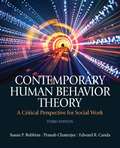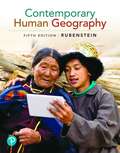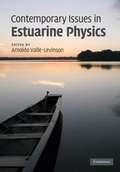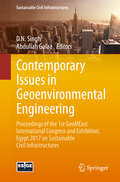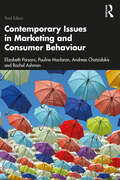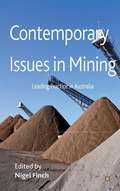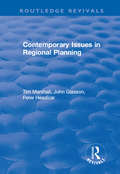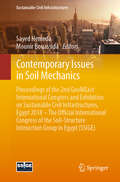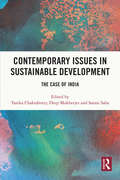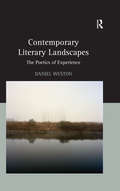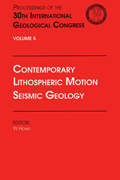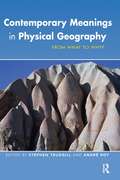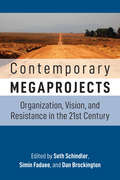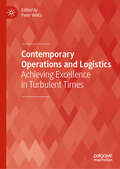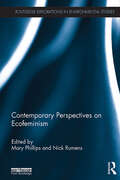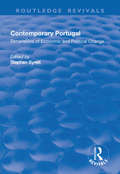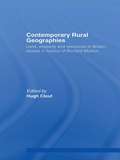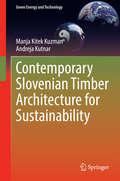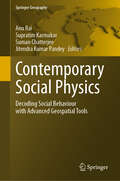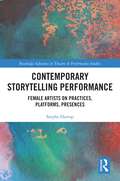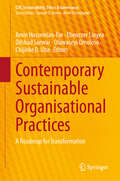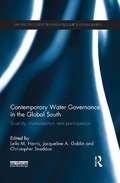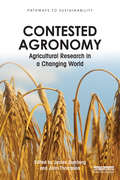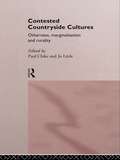- Table View
- List View
Contemporary Human Behavior Theory: A Critical Perspective for Social Work
by Susan P. Robbins Pranab Chatterjee Edward R. CandaContemporary Human Behavior Theory: A Critical Perspective for Social Work, 3e approaches HBSE from a comparative theory perspective, providing coverage of the most current and contemporary theories as well as traditional theories. It includes contemporary developments in traditional lifespan theory, theories of political economy, and a separate chapter on transpersonal theory. Each chapter includes coverage of the research that supports a particular theory, an analysis of the validity of that research, and a discussion of updated "Contemporary Issues. " The text encourages students to develop critical thinking skills in analyzing and comparing theories.
Contemporary Human Geography
by James M. RubensteinContemporary Human Geography incorporates a bold, highly visual approach to guide you in exploring physical and cultural landscapes across the globe. The modular organization and vibrant presentations work together to focus and engage you. Rubenstein describes past and current events and issues to show how their influence on diversity and globalization phenomena are at the core of contemporary human geography. The 5th Edition presents the latest geographical science and statistics, including current data on recent events. This edition incorporates applied examples of human geography, guiding you to understand the world on local, regional and global scales.
Contemporary Issues in Estuarine Physics
by A. Valle-LevinsonEstuaries are of high socioeconomic importance with 22 of the 32 largest cities in the world located on river estuaries. Estuaries bring together fluxes of fresh and saline water, as well as fluvial and marine sediments, and contain high biological diversity. Increasingly sophisticated field observation technology and numerical modeling have produced significant advances in our understanding of the physical properties of estuaries over the last decade. This book introduces a classification for estuaries before presenting the basic physics and hydrodynamics of estuarine circulation and the various factors that modify it in time and space. It then covers special topics at the forefront of research such as turbulence, fronts in estuaries and continental shelves, low inflow estuaries, and implications of estuarine transport for water quality. Written by leading authorities on estuarine and lagoon hydrodynamics, this volume provides a concise foundation for academic researchers, advanced students and coastal resource managers.
Contemporary Issues in Geoenvironmental Engineering: Proceedings of the 1st GeoMEast International Congress and Exhibition, Egypt 2017 on Sustainable Civil Infrastructures (Sustainable Civil Infrastructures)
by D N Singh Abdullah GalaaWith high urbanization rates, advancement in technologies, and changes in consumption behavior of people, wastes generated through the daily activities of individuals and organizations pose many challenges in their management. The articles presented in this edited volume deal with the attempts made by the scientists and practitioners to address contemporary issues in geoenvironmental engineering such as characterization of dredged sediments, geomaterials & waste, valorization of waste, sustainability in waste management and some other geoenvironmental issues that are becoming quite relevant in today's world. This volume is part of the proceedings of the 1st GeoMEast International Congress and Exhibition on Sustainable Civil Infrastructures, Egypt 2017.
Contemporary Issues in Marketing and Consumer Behaviour
by Pauline Maclaran Elizabeth Parsons Andreas Chatzidakis Rachel AshmanThis third edition of Contemporary Issues in Marketing and Consumer Behaviour has been revised and updated to reflect the fast-changing world we live in. The new state of the art chapter on digital marketing digs deeply into two new frontiers of marketing which have significant impact on contemporary social life: influencer marketing, and online gaming. Other new topics help us to understand how marketing can perpetuate local and global inequality through creating and sustaining hierarchies of knowledge and influencing norms of race, disability, gender and sexual orientation. Topics new to this edition include: Digital Markets and Marketing Hierarchies of Knowledge in Marketing Marketing Inequalities: Feminisms and intersectionalities The Ethics and Politics of Consumption New case studies include: Emerging Economy Brands The Fairtrade Brand Disappearing Influencers Decolonising the Media Written by four experts in the field, this popular text successfully links marketing theory with practice, locating marketing ideas and applications within wider global, social and economic contexts. It provides a complete and thought-provoking overview for postgraduate, MBA and advanced undergraduate modules in marketing and consumer behaviour and a useful resource for dissertation study at both undergraduate and postgraduate levels. Online resources include chapter-by-chapter PowerPoint slides.
Contemporary Issues in Mining: Leading Practice in Australia
by Nigel FinchContemporary Issues in Mining: Leading Practice in Australia by Nigel Finch
Contemporary Issues in Regional Planning (Routledge Revivals)
by John GlassonThis title was first published in 2002: Regional planning and government in the UK is undergoing a period of tremendous activity, with a wide range of new policies, innovative techniques and experiments being tested. This volume provides an overview of developments, describing and analyzing the legislative, political and economic contexts within which changes are occurring, and assessing the continuing difficulties that face planners and others operating in the new arrangements for regional planning
Contemporary Issues in Soil Mechanics: Proceedings of the 2nd GeoMEast International Congress and Exhibition on Sustainable Civil Infrastructures, Egypt 2018 – The Official International Congress of the Soil-Structure Interaction Group in Egypt (SSIGE) (Sustainable Civil Infrastructures)
by Mounir Bouassida Sayed HemedaThis volume is of interest to practical engineers. It discusses some contemporary issues related to soil mechanics in earthwork projects which are critical components in civil construction and often require detailed management techniques and unique solution methods to address failures. Being earth bound, earthwork is influenced by geomaterial properties at the onset of a project. Hence, an understanding of the in-situ soil properties is essential. Slope stability is a common problem facing earthwork construction, such as excavations and shored structures. Analytical methods for slope stability remain critical for researchers due to the mechanical complexity of the system. Striving for better earthwork project managements, the geotechnical engineering community continues to find improved testing techniques for determining sensitive properties of soil and rock, including stress-wave based, non-destructive testing methods. To minimize failure during earthwork construction, past case studies and data may reveal useful lessons and information to improve project management and minimize economic losses. This volume discusses these aspects using appropriate methods in a simple way. The volume is based on the best contributions to the 2nd GeoMEast International Congress and Exhibition on Sustainable Civil Infrastructures, Egypt 2018 – The official international congress of the Soil-Structure Interaction Group in Egypt (SSIGE).
Contemporary Issues in Sustainable Development: The Case of India
by Tanika Chakraborty Daeep Mukherjee Sarani SahaThis book analyzes different perspectives around sustainable development, risk management and managing demand across various sectors in India. Diverse theories and analytical methods from various disciplines, as well as case studies, are brought together to present an in-depth study. The book discusses the challenges of achieving sustainability, the role of quantitative research to assess current scenarios, and the role of policy making to bring improvements in the Indian context. It examines the socioeconomic ways of pursuing sustainable development in the areas of agriculture, climate change and energy; the environment and natural resources; health and society. It also analyzes important quantitative models for sustainability policy analysis and provides case studies to understand the practical implementations of the models. This book will be a great reference manual that covers a whole gamut of analytical techniques that are useful for students, research scholars and practitioners of economics, environmental studies, development studies, sociology, South Asian studies and public policy, among others.
Contemporary Kinetic Theory of Matter
by J. R. Dorfman Henk van Beijeren T. R. KirkpatrickKinetic theory provides a microscopic description of many observable, macroscopic processes and has a wide range of important applications in physics, astronomy, chemistry, and engineering. This powerful, theoretical framework allows a quantitative treatment of many non-equilibrium phenomena such as transport processes in classical and quantum fluids. This book describes in detail the Boltzmann equation theory, obtained in both traditional and modern ways. Applications and generalizations describing non-equilibrium processes in a variety of systems are also covered, including dilute and moderately dense gases, particles in random media, hard sphere crystals, condensed Bose-Einstein gases, and granular materials. Fluctuation phenomena in non-equilibrium fluids, and related non-analyticities in the hydrodynamic equations are also discussed in some detail. A thorough examination of many topics concerning time dependent phenomena in material systems, this book describes both current knowledge as well as future directions of the field.
Contemporary Literary Landscapes: The Poetics of Experience
by Daniel WestonWriting landscapes inevitably occurs in dialogue with a long textual and pictorial tradition, but first-hand experience also provides key stimuli to many writers’ accounts. This monograph employs a comparative lens to offer an intervention in debates between literary scholars who focus on genre and those cultural geographers who are concerned that self-perpetuating literary tropes marginalize practical engagements. Suggesting that representation and experience are not competing paradigms for landscape, Daniel Weston argues that in the hands of contemporary writers they are complementary forces building composite articulations of place. In five case studies, Weston matches a writer to a mode of apprehending place - W.G. Sebald with picturing, Ciaran Carson with mapping, Iain Sinclair with walking, Robert Macfarlane with engaging, Kathleen Jamie with noticing. Drawing out a range of sites at which representation and experience interact, Weston's argument is twofold: first, interaction between traditions of landscape writing and direct experience of landscapes are mutually influential; and second, writers increasingly deploy style, form, and descriptive aesthetics to recover the experience of place in the poetics of the text itself. As Weston shows, emergent landscape writing shuttles across generic boundaries, reflecting the fact that the landscapes traversed are built out of a combination of real and imaginary sources.
Contemporary Lithospheric Motion Seismic Geology: Proceedings of the 30th International Geological Congress, Volume 5
by Ye HongThis volume presents the results on contemporary geodynamic model, crustal stress field, active faults, folds and volcanoes. It discusses the tectonophysical environments of earthquake generation and the methodology of earthquake prediction.
Contemporary Meanings in Physical Geography: From What to Why?
by André Roy Stephen TrudgillOver the past twenty years, geography as an academic discipline has become more and more reflective, asking the key questions 'What are we doing?' 'Why are we doing it?'. These questions have, so far, been more enthusiastically taken up by human geography rather than physical geography. Contemporary Meanings in Physical Geography aims to redress the balance.Written and edited by a distinguished group of physical geographers, Contemporary Meanings in Physical Geography comprises of a collection of international writer's thoughts which reveal personal motivations, and look at tensions in the worlds of meaning in which physical geography is involved. How are the meanings of the physical environment derived? Is the future of physical geography one where the only, or at least the dominant, meanings are framed in the contexts of environmental issues.Covering a diverse and lively selection of topics, the contributors of this book offer guides to the contemporary debates in the philosophy of physical geography, and introduce the reader to its wider cultural significance. This book is an essential companion to anyone studying, or with an interest in, physical geography.
Contemporary Megaprojects: Organization, Vision, and Resistance in the 21st Century
by Seth Schindler, Simin Fadaee and Dan BrockingtonContemporary megaprojects have evolved from the discreet, modernist projects undertaken in the past by centralized authorities to encompass everything from large-scale construction to space exploration. Contemporary Megaprojects explores how these projects have been impacted by cutting-edge technology, the private sector, and the processes of decentralization and dematerialization. With case studies ranging from mega-plantations in Southeast Asia to ocean mapping to sports events, the contributions in this collected volume demonstrate the increasing ambition and pervasiveness of these projects, as well as their significant impact on both society and the environment.
Contemporary Operations and Logistics: Achieving Excellence in Turbulent Times
by Peter WellsThis edited collection collates the most up-to-date and important research within the area of operations and logistics management. Boasting the combined expertise of one of the largest logistics and operations management academic teams in Europe, it provides both depth and diversity in a balanced portfolio. The first two sections are concerned with key contemporary issues in the subject area, providing a current and up-to-date overview of the field. Section three presents a selection of important cross-cutting themes that impinge upon and inform teaching, research and practice, while the final section includes a celebration of research highlights and showcases cutting-edge applications from leaders in the field. Invaluable to students, researchers and academics alike, this book is compulsory reading for those active within operations and logistics research.
Contemporary Perspectives on Ecofeminism (Routledge Explorations in Environmental Studies)
by Nick Rumens Mary PhillipsWhy is ecofeminism still needed to address the environmental emergencies and challenges of our times? Ecofeminism has a chequered history in terms of its popularity and its perceived value in conceptualizing the relationship between gender and nature as well as feeding forms of activism that aim to confront the environmental challenges of the moment. This book provides a much-needed comprehensive overview of the relevance and value of using eco-feminist theories. It gives a broad coverage of traditional and emerging eco-feminist theories and explores, across a range of chapters, their various contributions and uniquely spans various strands of ecofeminist thinking. The origins of influential eco-feminist theories are discussed including key themes and some of its leading figures (contributors include Erika Cudworth, Greta Gaard, Trish Glazebrook and Niamh Moore), and outlines its influence on how scholars might come to a more generative understanding of the natural environment. The book examines eco-feminism's potential contribution for advancing current discussions and research on the relationships between the humans and more than humans that share our world. This timely volume makes a distinctive scholarly contribution and is a valuable resources for students and academics in the fields of environmentalism, political ecology, sustainability and nature resource management.
Contemporary Portugal: Dimensions of Economic and Political Change (Routledge Revivals Ser.)
by Stephen SyrettThis title was first published in 2002. Portugal experienced rapid and dramatic change over the final decades of the twentieth century. After the turbulence that followed the 1974 revolution, the 1980s and 1990s provided a period of unprecedented political stability and economic modernization during which Portugal converged rapidly with the wealthier member states of the European Union. This important new volume offers a timely focus on this recent period. Written for a wide audience by a multidisciplinary team of experts, the book provides an accessible overview and analysis of the key dimensions of recent economic and political change in Portugal and identifies the tensions and policy challenges that rapid change has produced. In so doing the book reveals something of the complexity of contemporary Portugal: an outward looking modern, democratic and European state, but one where the legacy of its recent traditional, colonial and often inward looking past continues to influence and shape its development in the twenty-first century.
Contemporary Rural Geographies: Land, property and resources in Britain: Essays in honour of Richard Munton
by Hugh CloutThis book provides a cohesive set of research statements on critical related issues in British rural geography, as well as echoing the priorities identified by an influential figure in British rural geography, Richard Munton. This book demonstrates that the rural world needs to be seen in a far wider perspective than that of agriculture/ food production, in order to comprehend how resources are being appraised and exploited in new ways, and to respond to the pressing challenges of sustainability for the decades ahead. Chapters adopt a time perspective to explore a series of key themes: the rise of productivist farming ways of conceptualising agricultural change the evolution of landownership and property rights rural and urban agendas for nature conservation the gap between policy and action for sustainable development. The final set of chapters is devoted to policy-related issues associated with agricultural change and the profound challenge of rural diversification for the future. The last chapter traces the prominent career of Richard Munton.
Contemporary Slovenian Timber Architecture for Sustainability (Green Energy and Technology)
by Andreja Kutnar Manja Kitek KuzmanThe book presents Slovenia's contemporary timber architecture. Thanks to its abundant forests, Slovenia has preserved the tradition of wood construction. As much as 60% of its surface is covered by forests. Slovenia is also the third most forested country in Europe. The high share of forest-covered surface allows for a sustainable production of high-quality wood. In the past, wood was used primarily in the construction of farm buildings, but now timber architecture is used for everything from residences and office buildings to public buildings such as community centres and schools. Timber construction is becoming increasingly popular. Apart from larger companies taking this approach, a great number of wooden houses have sprung up, built either on personal initiative or with the support of carpenter workshops. Slovenian timber architecture has taken a new approach to environmental and energy-efficiency problems and received great international recognition. The book discusses over fifty projects built over a ten-year period, and includes descriptions, photographs and plans. The projects include residential areas, administration, and office as well as tourist, educational and industrial buildings. Timber architecture is presented as an integral part of the Slovenian landscape. The monograph will be useful to designers and future experts in their planning of optimal timber buildings and will highlight the main benefits of using timber construction.
Contemporary Social Physics: Decoding Social Behaviour with Advanced Geospatial Tools (Springer Geography)
by Jitendra Kumar Pandey Anu Rai Supratim Karmakar Suman ChatterjeeThis volume delves into how cutting-edge geospatial tools are revolutionizing social physics—the quantitative study of human behavior and spatial dynamics. Through real-world case studies, the book demonstrates how geospatial analysis is applied to pressing social and environmental challenges, from migration flows and resource distribution to healthcare access, crime, disaster management, and urban planning. Readers will explore how these tools reveal the complexities of human movement, socio-spatial interactions, and behavioral patterns. The book is structured into five sections, each tackling key topics at the intersection of social physics and geospatial analysis: Population Dynamics and Social Behavior: Examines refugee settlements, migrations, resource allocation, and the socio-spatial impacts of political violence and the COVID-19 pandemic. Social Learning and Environmental Management: Highlights how social learning influences agriculture, healthcare, and environmental management, with geospatial techniques improving outcomes like riverbank stability and crop yields. Spatial Heterogeneity and Social Behavior: Investigates how social behavior shifts across different spatial contexts, with a focus on crime, inequality, and pandemic response, including detailed insights into Kolkata’s COVID-19 management. Social Physics and Sustainability: Demonstrates how geospatial tools can advance sustainability efforts, including waste management, transportation optimization, and urban planning for peri-urban areas. Ideal for academics, researchers, urban planners, and policymakers, this volume provides innovative methodologies to address complex social, environmental, and economic challenges. Whether examining migration trends or advancing sustainability, this book equips readers with the tools to transform how we understand human behavior and space.
Contemporary Storytelling Performance: Female Artists on Practices, Platforms, Presences (Routledge Advances in Theatre & Performance Studies)
by Stephe HarropThis book focuses on a rising generation of female storytellers, analysing their innovation in interdisciplinary collaboration, and their creation of new multimedia platforms for story-led performance. It draws on an unprecedented series of in-depth interviews with artists including Jo Blake, Xanthe Gresham-Knight, Mara Menzies, Clare Murphy, Debs Newbold, Rachel Rose Reid, Sarah Liisa Wilkinson, and Vanessa Woolf, while Sally Pomme Clayton’s reflections on her extraordinary four-decade career provide long-term context for these cutting-edge conversations. Blending ethnographic research and performance analysis, the book documents the working lives of professional storytelling artists. It sheds light on the practices, values, aspirations, and achievements of a generation actively re-defining storytelling as a contemporary performance practice, taking on topics from ecology and maternity to griefwork and neuroscience, while working collaboratively with diverse creative partners to generate new, inclusive presences for a traditionally-inspired artform. This book will be of great interest to students, scholars, and practitioners in drama, theatre, performance, creative writing, education, and media.
Contemporary Sustainable Organisational Practices: A Roadmap for Transformation (CSR, Sustainability, Ethics & Governance)
by Amin Hosseinian-Far Dilshad Sarwar Ebenezer Laryea Oluwaseyi Omoloso Chijioke D. UbaThis book provides a structured overview of contemporary sustainable organisational practices. It examines the contemporary sustainability landscape within the pillars of environment, economy and society and provides case examples for each topic. The book features discussions on sustainable governance and strategy, systems approach, and social responsibility. It is a multidisciplinary work that cuts across several subject areas ranging from strategy, business and organisational management, environmental management, engineering, to systems thinking. This book is suitable for scholars, researchers, academics, and policy makers interested in sustainability and organisational management and practice.
Contemporary Water Governance in the Global South: Scarcity, Marketization and Participation (Earthscan Studies in Water Resource Management)
by Leila M. Harris, Jacqueline A. Goldin and Christopher SneddonThe litany of alarming observations about water use and misuse is now familiar—over a billion people without access to safe drinking water; almost every major river dammed and diverted; increasing conflicts over the delivery of water in urban areas; continuing threats to water quality from agricultural inputs and industrial wastes; and the increasing variability of climate, including threats of severe droughts and flooding across locales and regions. These issues present tremendous challenges for water governance. This book focuses on three major concepts and approaches that have gained currency in policy and governance circles, both globally and regionally—scarcity and crisis, marketization and privatization, and participation. It provides a historical and contextual overview of each of these ideas as they have emerged in global and regional policy and governance circles and pairs these with in-depth case studies that examine manifestations and contestations of water governance internationally. The book interrogates ideas of water crisis and scarcity in the context of bio-physical, political, social and environmental landscapes to better understand how ideas and practices linked to scarcity and crisis take hold, and become entrenched in policy and practice. The book also investigates ideas of marketization and privatization, increasingly prominent features of water governance throughout the global South, with particular attention to the varied implementation and effects of these governance practices. The final section of the volume analyzes participatory water governance, querying the disconnects between global discourses and local realities, particularly as they intersect with the other themes of interest to the volume. Promoting a view of changing water governance that links across these themes and in relation to contemporary realities, the book is invaluable for students, researchers, advocates, and policy makers interested in water governance challenges facing the developing world.
Contested Agronomy: Agricultural Research in a Changing World (Pathways to Sustainability)
by John Thompson James SumbergThe dramatic increases in food prices experienced over the last four years, and their effects of hunger and food insecurity, as well as human-induced climate change and its implications for agriculture, food production and food security, are key topics within the field of agronomy and agricultural research. Contested Agronomy addresses these issues by exploring key developments since the mid-1970s, focusing in particular on the emergence of the neoliberal project and the rise of the participation and environmental agendas, taking into consideration how these have had profound impacts on the practice of agronomic research in the developing world especially over the last four decades. This book explores, through a series of case studies, the basis for a much needed ‘political agronomy’ analysis that highlights the impacts of problem framing and narratives, historical disjunctures, epistemic communities and the increasing pressure to demonstrate ‘success’ on both agricultural research and the farmers, processors and consumers it is meant to serve. Whilst being a fascinating and thought-provoking read for professionals in the Agriculture and Environmental sciences, it will also appeal to students and researchers in agricultural policy, development studies, geography, public administration, rural sociology, and science and technology studies.
Contested Countryside Cultures: Rurality and Socio-cultural Marginalisation
by Paul Cloke Jo LittleThis book examines the 'other' side of the countryside, a place also inhabited (and visited) by women, children, teenagers, the elderly, gay men and lesbians, black and ethnic minorities, the unemployed and the poor. These groups have remained largely excluded by both rural policies and the representations of rural culture. The book charts the experiences of these marginalised groups and sets this exploration within the context of postmodern, poststructuralist, postcolonial and late feminist analysis. This theoretical framework reveals how notions of the rural have been created to reflect and reinforce divisions amongst those living in the countryside.
